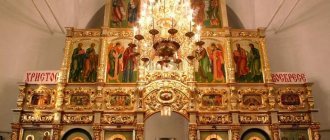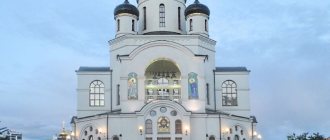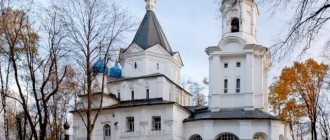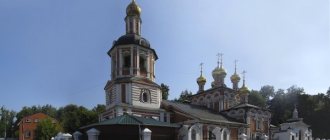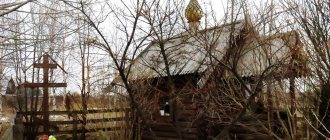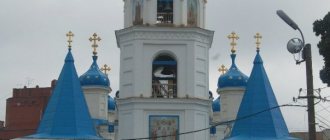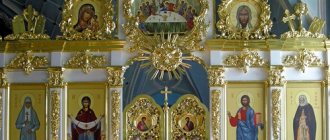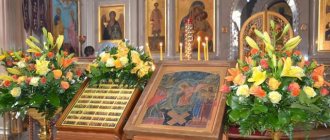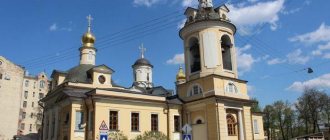The Butovo training ground is the largest site of mass executions and burials of victims of Stalinist repressions in the Moscow region. The tract is located near the village of Drozhzhino, in which, according to research, more than 20 thousand people were shot between 1930 and 1950.
Patriarch of All Rus' Alexei II called the training ground a place of severe trials and torment, namely the “Russian Golgotha.” Among the victims here, about 1,000 people are representatives of the clergy: both the Russian Church and other denominations. More than 300 of them are glorified as saints.
Since the summer of 2001, the Butovo test site, according to the Decree of the Government of the Moscow Region, began to be considered a monument of history and culture.
Monument to the memory of victims, © jY-m-htp
Temple today
The Church of the New Martyrs and Confessors of Russia in Butovo is located in the zone of the old secret facility of the NKVD. During Stalin's repressions, mass executions and burials were carried out in this place.
In total, during the year of the Great Terror, over 20 thousand people were shot at this place, about a thousand of whom were ministers and parishioners of the Russian Orthodox Church, who accepted their death for their faith and Christ. Many of those killed here are canonized as saints.
Ascetics who suffered for the Lord, testifying about him and his resurrection, are usually called the word “witness” or “martyr.” Therefore, it is not surprising that the temple was consecrated not only in the name of new martyrs and confessors, but also in honor of the Resurrection of Jesus Christ and began to be called the Church of the Resurrection of Christ and the New Martyrs and Confessors of Russia.
The site, in turn, received the definition of “Russian Golgotha,” because in all the canonical divisions of the Russian Orthodox Church there are no longer places equal in the number of resting holy relics. Now this place is known throughout the world. Pilgrims come here, both from Russia and from other countries.
Butovo - Russian Golgotha
My interlocutor is Dmitry Grishin.
He comes from the Samara province, from Syzran. He graduated from St. Tikhon's Theological Institute in Moscow. And when he entered it, he moved to live on the southern outskirts of Moscow in the village of Butovo - with the blessing of the rector of the Church of the Holy New Martyrs and Confessors of Russia, priest Kirill Kaleda. Dmitry works in this church at the Butovo training ground and teaches at Sunday school. I met him at the “Orthodox Rus'” exhibition in Moscow at the end of January this year. There was a separate stand “Butovo - Russian Calvary”. I had heard before about the Butovo firing range, where thousands of people, many Orthodox priests, were shot, and I have long wanted to know more about it. A large panoramic photograph in the exhibition attracted attention: on a clear spring day at the Butovo training ground - many clergy, surrounded by laymen, are performing a solemn service. There was some kind of extraordinary silence emanating from the photograph. I asked Dmitry to tell me about the Butovo training ground. He and I sat on some boxes and talked quietly among this noisy exhibition, and I was unable to take my eyes off this photo. As if finding himself right there, at the training ground, slowly, step by step, as his story progresses, plunging into this unworldly ringing silence. Execution books
“The photograph shows the laying of the foundation stone of a new stone church by Patriarch Alexy II of Moscow and All Russia in May last year in honor of the Holy New Martyrs and Confessors of Russia in Butovo,” Dmitry explained. “We have built a wooden temple, but this will be a stone one.” A delegation of the Russian Church Abroad headed by Metropolitan Laurus was present at the foundation stone of the temple. Now the walls of the temple have already been erected, the construction of tents has already begun. This was such a strong prayer for this. — About the Butovo training ground became known not so long ago?
— The fact that on the southern outskirts of Moscow there was a shooting range of the NKVD, where in the 30-40s of the last century mass executions and burials of victims of political repressions were carried out, became known only in the early 90s. In 1993-94, a commission that worked in the KGB archives noticed that in several execution books (eighteen in total) there were a lot of names of clergy. But where these executions took place was still unclear. And only in a private conversation with state security workers did it become known that this was Butovo. Since 94-95, believers began to come there and pray there, whose grandfathers and fathers were repressed during the persecutions, were listed as missing, or they received a document that “died of illness” - then they did not write that the person was shot . This commission began to study the execution books, and about a thousand names of clergy and laity of the Russian Orthodox Church were identified who suffered in Butovo precisely for the Orthodox faith. Today, 294 of them have been canonized. At the head of this list is the Hieromartyr Metropolitan of Petrograd Seraphim (Chichagov) and six other Bishops. Vladyka Seraphim was the first to be canonized from the entire host of Butovo New Martyrs. According to these eighteen execution books, a total of twenty thousand seven hundred sixty-five people were killed in Butovo. Executions in the Moscow region began on August 8, 1937, after the bloody orders of the People's Commissar of the NKVD Yezhov in August and September 1937. Those sentenced to death were brought here from Moscow prisons. Those executed are mainly residents of Moscow and the Moscow region, but there are also residents of other regions and foreigners. Those executed at the Butovo training ground belonged to the “espionage-sabotage-terrorist ranks,” that is, they were mostly ordinary workers and peasants. But among them there were also famous government and public figures, military men, intellectuals, and clergy. In 1997, an excavation was made at the site in one of the execution ditches, and scientists said that if the same density of remains was in other ditches, then there were a hundred thousand people lying there. But research work requires very large financial investments.
Butovo training ground
— What is the Butovo training ground?
— This is the former Drozhzhino estate, its last owners were the merchant-industrialists Zimins.
After the revolutionary coup of 1917, there were state farms and objects subordinate to the OGPU-NKVD: a labor colony of the NKVD, vegetable gardens from which NKVD employees were supplied, and their dachas. It was a rural area back then. But now urban construction is increasingly taking place there, although the landfill itself is located in a green zone. — Why is this place called the Butovo training ground?
— In these economic territories, the NKVD allocated a place for firing new weapons, which were made at the Podolsk arms factory.
This was a training ground where weapons were fired. Local residents were accustomed to gunshots several years before mass shootings began there. Following Yezhov's decree, any person could be accused of anything. — Do you know what the execution procedure was?
“They passed at night, secretly, because people lived in neighboring villages.
Those sentenced to death were brought to Butovo in covered vans, without being told where or why they were being taken. They took me into a barracks, supposedly for “sanitation.” Here they announced the execution, checked the data and the presence of photographs. They were taken out to be shot one at a time. This is only oral evidence because all traces have been covered. There are only investigative documents, interrogation records, as well as documents of those who carried out the sentence. When the archives were opened, they allowed everyone to read, but now the testimony of witnesses, that is, essentially denunciations, is not shown. We also did not see the instructions of the firing squads. — Have you raised all the graves?
- Of course not.
This is simply impossible now. —What do the burials look like?
“These are burial ditches, they were best visible in winter: when the ground was covered with snow, the parts of the ditches were somewhat sagging. Research work was carried out, and scientists have already accurately determined the burial sites. The KGB had a diagram of execution ditches, but it turned out to be not entirely accurate. Now the boundaries of the ditches are precisely defined, marked by fencing and planting flowers. And before that they weren’t really visible. A person who got there by chance would never have guessed that executions were carried out there. Recently, the Moscow Government developed a project for the improvement of the Butovo landfill and the creation of a memorial complex on this site.
The most mass executions took place from August 1937 to July 1938. There is unconfirmed evidence that people who were executed in Moscow prisons before the 50s were brought there to bury them, but this is only oral evidence. This territory still remained under the control of the KGB, an orchard was planted there, there were even some dachas for the heads of the NKVD, something was built over the years. The territory was classified; there was always a military unit there. Now there is a small park on this site. — Were the remains of specific people found?
- No.
To do this, apparently, some very complex research must be carried out. Judging by the excavation that was done in 1997, there are no complete remains of, say, a human skeleton. Everything is mixed up there. Because only at the beginning people were buried there in small burial pits. The executions soon assumed such proportions that ditches three meters deep and 150 meters or more long were dug with a powerful excavator. After the next execution, a thin layer of bodies was sprinkled with a bulldozer, and new victims were laid on top of these bodies. All this was completely inhumane. They filled the ditches with whatever they wanted, with garbage. — And the remains of the executed people are now impossible to find and identify?
But how many holy relics of martyrs are there... - With modern means of science, apparently, this is possible, but it’s even difficult to imagine how much money it will require. We pray in church for everyone - for all these twenty thousand who were shot there. We are serving a funeral service. Several times a year, special funeral services and memorial services were held, which were attended by many people, not only the Orthodox. People of different religions, more than sixty nationalities, were shot at the training ground. When a memorial service is held, perhaps not everyone is named by name, but everyone who was shot there is meant. We believe that the duty of any believer is to pray for all those killed. Lord Seraphim was the first to be glorified in 1997. And now, when the Russian Orthodox Church has already glorified 294 people who suffered at the Butovo training ground - clergy, monastics, active laity - on the fourth Saturday after Easter, a very solemn service is held in the open air at the Butovo training ground in honor of the New Martyrs, victims in Butovo, led by His Holiness Patriarch Alexy II. A lot of people gather for it, the clergy - several thousand people.
Temple on blood
— Tell us about the temple at the Butovo training ground.
— When this territory - six hectares - was transferred to the Russian Orthodox Church in 1995, there were simply weeds the size of a man. And immediately a project was made to build the Church on the Blood, on the relics of the New Martyrs. It is interesting that the dates associated with the construction of the temple coincided, by the will of God, with the dates of the life of the holy martyr Seraphim (Chichagov). Thus, the minor consecration of the temple fell on December 11, the day of remembrance of Lord Seraphim. He was shot on December 11, 1937 at the age of eighty-two. He didn't even walk anymore. He lived near Moscow in Ukhtomskoye, and in order to take him to the place of his martyrdom, they called an ambulance because he could not move independently. The wooden church was built in 1996; its altar comes close to one of the execution ditches. The single-domed temple, modeled on northern Russian churches, was created according to the design of the son of Priest Mikhail Shik, who was executed at the Butovo training ground, the famous artist and architect Dmitry Mikhailovich Shakhovsky-Shik. He was a member of the initiative group and personally participated in the construction of the temple. In the temple itself there is a cross with the relics of some new martyrs, but not those of Butovo. Basically, the parish of the temple now consists of local residents. At first, a lot of people came from Moscow, relatives of the victims. The rector, priest Kirill Kaleda, while still a layman, headed an initiative group that advocated for this place to be transferred to the Church. His grandfather, the holy martyr Vladimir Ambartsumov, was shot at the training ground. Then Father Kirill was the head of the parish community, and when the church was founded, he was ordained a priest and became rector. He tries to repay the debt to the memory of people who gave their lives for the faith and the Russian Church. The Lord has vouchsafed the Russian Church to have many such amazing saints who are so close to us in time, their children are alive, the people who knew them are alive, and through their stories we can touch the holiness of their lives.
Photos from investigative cases
— Do you have their icons here at your stand?
— Yes, this is a row of icons of the holy New Martyrs who suffered for Christ at the Butovo training ground. This is Vladyka Seraphim (Chichagov) himself; in the center of the exhibition is a copy of the icon “The Savior in the White Tunic,” painted by the Vladyka himself. The original of this icon is in the Church of St. Elijah the Ordinary in Moscow. Here is a table of the dynamics of executions. The peak of executions was in February 1938. In just one day, February 28, 562 people were shot! There are no executions on Soviet holidays; NKVD officers on these days, like all Soviet citizens, rested. After February, the executions begin to decline and soon stop. The photographs from the investigations are simply stunning. My dream is for them to be published as a separate photo album. It is impossible to tell from these faces that these are ordinary photographs. These are icons. Those eyes looking at you just pierce your soul. Mostly, of course, the photographs of people who suffered because they were Christians amaze us. In not a single investigative case on a church issue are there slander either against oneself or against others, no one admits guilt in being accused of some kind of counter-revolutionary propaganda. And Hieromartyr Vladimir Ambartsumov openly said right during interrogation that this power is not from God, it is temporary, and it will soon pass. On the contrary, investigative cases even infect non-believers and non-church people with their severity and hopelessness. People who worked with these documents talked about this. Investigative cases of even such strong people as climbers (an entire group of climbers were shot at the Butovo training ground) are full of accusations against each other, saturated with fear and betrayal. A person who did not have a core of faith, who did not have hope in God, in those circumstances lost all his human dignity, despite the fact that in ordinary life he could be a hero. He did not turn to God for help in prayer, but the Lord strengthened the believers in this situation.
Bloody map of Moscow
— Dmitry, why do you think the Lord brought you to this particular temple?
- I ask myself this question. I have an explanation for myself. When I first came to church, I had some sorrow that there was no famous saint on my birthday. Once, when I was still living in Khotkovo, in the evening I listened to Radio Radonezh, and priest Sergius Pravdolyubov talked about the Butovo training ground. And I immediately thought, it would be nice to visit this place. And then they started talking about Vladyka Seraphim Chichagov and said that he was shot on December 11 - and this is my birthday! When I entered the St. Tikhon's Institute, I met Father Kirill, and there was an opportunity to find shelter at the church. Father Kirill sheltered my entire family. This happened, perhaps, so that I could work specifically to glorify the feat of the New Martyrs. Butovo is the foundation of our modern church revival. Here in the ground lie people who walked the path of Christ, who gave their lives for their friends. If not for their feat, it is difficult to imagine what would happen to Russia now. This is the only place in Russia where there are so many saints glorified by the Church. If before this the Kiev Pechersk Lavra occupied the first place in terms of the number of saints, then, of course, now it is the Butovo training ground, the place where the host of New Martyrs is. The south of Moscow is a bloody map. In Moscow itself there are also many such places, but not on the same scale. The south of Moscow is Butovo, a little west of Kommunarka and a little east of Sukhanovo. These are three places near Moscow where mass executions and burials took place. In Kommunarka, the “conspiratorial elite” were executed; many famous people died here - Rykov, Bukharin, Bubnov and others. There the authorities shot themselves, mostly NKVD officials and major military leaders died there, there are almost no Orthodox Christians there. In the Sukhanovskaya prison, which was located in the St. Catherine's Monastery, prisoners were subjected to severe torture and endured inhuman suffering before death. But only in Butovo were so many priests shot.
Butovo apples
— Do you feel the sacredness of this place?
- This is a place of some great silence. Moreover, even non-church people, when they come to Butovo, also talk about it. The Butovo training ground itself is located in a forest park, and if you walk from the Varshavskoe highway, then, after passing a modern microdistrict, you enter the forest. And there is a feeling that you are crossing some kind of border. The bustle remains behind, and you enter a world of peace and quiet. Although some sounds are heard, the heart calms down. You are entering a world that brings you closer to eternity. This is a place of inner silence. When a person gets to the Butovo training ground, all the vanity, all the depth of thoughts that are spinning around him suddenly disappear. And man directly perceives the nearness of God. And those who came there once always strive to get there again. The mass glorification of the New Martyrs took place at the anniversary Council of Bishops of the Russian Orthodox Church in 2000. Over a thousand new martyrs were canonized there. Among them were 128 clergy killed at the Butovo training ground. The glorification took place in August, just before the Feast of the Transfiguration, which is popularly called “Apple Savior.” The far part of the Butovo training ground, where people usually do not go, is a continuous apple orchard. But we didn’t see apples on the trees from year to year, because the trees were apparently sick. And in August 2000, on Yablonevy Spas, these trees were simply bursting with apples, in the literal sense - the branches were breaking from the abundance of apples. After that, there was never a harvest on these apple trees again.
Ganina Yama, where the bodies of the Royal Martyrs were burned in July 1918, is called the Russian Golgotha. The entire land there is saturated with their flesh and blood, and the entire Ganina Yama represents, according to His Holiness Patriarch Alexy II of Moscow and All Rus', the Antimins of the Russian Land. His Holiness the Patriarch and Butovo called it Russian Golgotha. The flesh and blood of the New Martyrs permeated this land and consecrated it. Both on Ganina Yama and in Alapaevsk on Mezhennaya Yama, where Grand Duchess Elisaveta Feodorovna was thrown into a mine, you find yourself in another dimension. Behind the monastery fence there is silence, unearthly beauty, trees, flowers, grass, the sky seem to transform and become different in the blink of an eye. They no longer belong to the earth, but to eternity. Every Russian person should visit Ganina Yama and Alapaevsk, pray, kneel down, and water this blood-soaked holy and dear land with his hot tears of repentance. The same is true here. We need to go to Butovo. From the Moscow metro station “Dmitry Donskoy Boulevard” there is bus number 18 to the final stop: “Butovsky Polygon”.
In the photographs: in 1994, a large Poklonny cross was erected on the long-suffering land of Butov;
His Holiness Patriarch Alexy II and the First Hierarch of the Russian Church Abroad, Metropolitan Laurus, lay the foundation stone for a new stone church at the Butovo site on May 15, 2004; Dmitry Grishin at the exhibition “Orthodox Rus'” at the icon “The Savior in the White Tunic”, painted by Metropolitan Seraphim (Chichagov). Lyudmila Belkina 02/11/2005
Architect, exterior decoration, architectural ensemble
The first temple was built in the style of ancient Russian churches from wood and was temporary. Its architect was Dmitry Shakhovsky, the son of Priest M. Shik, who was killed at the training ground. The new temple is made in the style of tent architecture. The author of his project was Mikhail Yurievich Kesler.
The originality of the architectural solutions lies in the rarity of five-tent churches as such. In addition, the structure rests on a foundation of a special design, thanks to which the temple looks like it was built on a hill. From the outside, the monastery is presented in white and golden color with figured columns, arched friezes, elongated thin windows and arched openings.
An elegant staircase leads to the lower church (crypt). The bells depict images of saints. Also on the premises of the temple, but in a different room, there is a Museum in memory of the victims, which bears the name.
The painting of the cathedral was done by a group of artists in the field of monumental painting under the direction of K. V. Okhotin. The main subject of the wall paintings in the lower church is the Carrying of the Cross (the path of Jesus’ suffering), in the upper one – the Resurrection of Christ.
Lists of those executed
Nationalists and clergy were shot first. 374 “churchmen” were killed and buried here: Metropolitan Seraphim, a dozen deacons, sextons and readers.
The bulk of the victims were residents of Moscow or the Moscow region, but there were also those who came to the Union from other states or continents, naively believing that they would be able to build communism. A large number of those repressed are foreigners. Among them there are natives of the USA and Argentina, Indians, Afghans, Germans, Latvians, Poles, and many others.
The youngest of those killed was Misha the street child. He was punished for stealing two loaves of bread. It was possible to shoot only from the age of 15, but at the time of the repressions the boy was only 13 years old. The date of birth was corrected, and the homeless child was deprived of his life.
© Black man
They also killed for less, for example, for the tattoo of Joseph Vissarionovich on his leg. Sometimes entire families were shot, 6–9 people at a time. It happened that in villages, for example, from the village of Petrovo in the Ryazan region in Butovo, 18 people were immediately shot.
Virtual guide (tour of Russian Calvary)
The burials took place without a church or civil memorial service, and without notifying relatives. The names of all those killed at the training ground are still unknown. Relatives of those executed began receiving death certificates only in 1989.
Accurate information is available about people who suffered between August 1937 and October 1938. Only more than 3 thousand people have been identified by name. Of those executed during the specified period, as of October 2003, 15,166 people were rehabilitated. And 5,595 people who were executed under mixed and criminal charges have not been rehabilitated to this day.
Execution ditch, © Alexander R.Karanik
History of construction
In the early 90s, a group of enthusiasts, consisting mainly of relatives of those killed in Butovo, under the leadership of M. B. Mindlin and with the help of various government services, decided to perpetuate the memory of the victims of the Yezhovshchina. The group began its activities with archival and investigative cases of those executed at the Butovo training ground, collecting information for the planned “Book of Memory”.
Starting next year, relatives of the victims began visiting the site. During this period, a memorial plaque was installed on its territory.
Then in 1994, in the middle of the tract, near the burial grounds, the 1st Poklonny cross, made of wood specifically according to the plan of the architect D. M. Shakhovsky, was installed and consecrated. He also developed a project according to which in 1996 (after the transfer of the burial zone to the Moscow Patriarchate of the Russian Orthodox Church) a small single-altar church made of wood was erected and consecrated.
After its creation, a stone temple was laid according to the architectural plan of M. Yu. Kesler. The work was completed at the beginning of 2007. At the same time, His Holiness Patriarch Alexy II, together with the First Hierarch of the ROCOR Laurus, conducted the rite of consecration of the new church.
Story
The village of Drozhzhino was first mentioned in the middle of the 16th century, when the estate of the boyar F.M. Drozhzhin was located here. It is known that at the end of the 19th century. the owner of the estate, N. M. Solovyov, founded a stud farm on the territory, and built a hippodrome near the forest. After the October Revolution, I.I. Zimin (who was the owner of the estate at that time), without waiting for confiscation, transferred the entire farm to the government, and he himself went abroad.
In 1920, an agricultural colony of the OGPU appeared in Butovo. In 1934, the Butovo training ground was created here, which was used as a shooting range for the NKVD (the territory occupied 2 sq. km). The shooting range was surrounded by a solid fence, was under round-the-clock armed guard and was perfect for executions.
Convicts were sent towards the Drozhzhino estate in the evenings on grain trucks. At the training ground they were placed in a long barracks, where roll call and verification of people took place.
Immediately before the execution, the victim’s face was compared with the photograph on the documents, after which the verdict was announced. The action continued until dawn.
© jY-m-htp
The capital's cemeteries could not accommodate such a number of executed people, so people were buried like a layer cake - they killed those standing near the ditch, covered them with earth, and buried the next victims on top. There are 13 such pits at the site. The width of each was 4–5 m, and the depth reached 4 m.
In the summer of 1937, executions reached such proportions that there were no longer enough burial pits for burying bodies. Then, with the help of an excavator, they began to dig trenches 3–5 m long and 3.5 m deep.
After the cessation of mass executions, in 1938 the tract began to be used for the burial of those who were shot in Moscow prisons.
During World War II, a camp for German prisoners of war was created in the area of the Russian Calvary. Their forces were involved in the construction of the Warsaw Highway. Those who refused to take part in the construction were shot and thrown into the ditch.
Lists of those executed on Google Maps panorama
Interior decoration
The Church of the Resurrection of Christ and the New Martyrs and Confessors of Russia in Butovo is divided into two floors.
Lower
Dedicated to the suffering of those who died a martyr's death here. In the lower church there is a reliquary with the remains of objects (clothing, shoes, etc.) found during excavations of burials. In its vestibule there are also pre-mortem photographs of those killed in Butovo.
The predominant storyline of the paintings in the lower part of the temple complex is represented on the ceiling. This is the path of Jesus' suffering. On the walls is the Butovo Menaion of 51 images of the new martyrs. The Butovo saints are shown here according to the days of their death and memory. These icons are placed in a clear clockwise order around the temple.
Chapels of the lower temple
In total, 3 chapels were created, each of which has its own meaning:
- The central one is dedicated to the Mother of God of the Sovereign.
- The right one was consecrated in honor of Metropolitan. Seraphim (the oldest murdered saint).
- The left one was created in the name of St. John of Shanghai.
Upper
It is dedicated to praising the feat of the Butovo victims.
The main plot of the entire painting here is dedicated to the Resurrection of Christ. A significant proportion of the plots of one of the parts of the church (the left side chapel) are dedicated to the life of St. Tikhon. The other is dominated by images of martyrs, both ancient and modern. There are pictures of the murder of the royal family, the murder of Bishops Vladimir and Benjamin.
In the house of God there are also images of the Butovo saints. They are represented by 51 full-length frescoes (1 saint from the 1st day of execution). On the arches are the country's bishops from different places of service. So, for example, if the service took place in the south of the state, then they are located in the southern part of the monastery.
This suggests that in every corner of the country there were those who testified to the resurrection of the Savior at the cost of their lives. In front of the altar in the main altar there are 2 icons: the new martyrs and confessors of the Russian Church, and the second - those who died for the faith in Butovo.
Chapels of the upper temple
They carry the main semantic load inherent in the internal contents of the temple:
- the central one represents the Resurrection of the Lord;
- the right one was created in memory of St. new martyrs and confessors of Russia;
- the left one bears the name of St. Tikhon.
In Russia the persecutors were yesterday's Christians
From the first days of its existence, the Church of Christ became the Church of martyrs. Active persecution of the ancient Church continued from the first days of its foundation until the edict of Emperor Constantine, but in subsequent times persecution of Christians occurred in certain countries. In the last twentieth century, persecution of Christianity again swept across many countries.
In Spain during the civil war of 1936-1939. About seven thousand Catholic clergy and religious were killed. In Nazi-occupied Poland from 1939 to 1941. 700 Catholic priests were killed and about three thousand clergy were exiled to concentration camps. In Croatia, almost 700 people suffered for the Christian faith during the Nazi regime and subsequently under J. Tito. In Mexico, from 1926 to 1929, during the so-called Cristeros War, about 500 Catholic priests, religious and seminarians were killed. Today we are witnessing the persecution of Christians in the Middle East.
In the twentieth century, the persecution of the Church of Christ reached its apogee in Russia, where it continued almost continuously for 70 years.
According to recent estimates, about 100,000 clergy, monastics and laity of the Russian Orthodox Church suffered during this period.
Comparing the situation of Christianity in the Roman Empire with the era of persecution of Christians in the twentieth century in Russia, one can notice both similarities and some differences.
Speaking about persecution in early Christian times, historians note that in Ancient Rome, pagan religion was closely intertwined with the idea of statehood. Statehood itself was a subject of religious veneration. By rebelling against this religion, Christians became guilty of a state crime.
The persecution of Christians in ancient times was distinguished by long periods of peace between them and the short duration of the persecution itself, its non-simultaneity throughout the territory of the empire, so that one or another bishop could retire with his entire flock to a deserted place and remain there until the end of the persecution. This was completely impossible during the persecution in Soviet Russia, where persecution was widespread, incessant, and there was no place in the country where a Christian could hide.
The basis of communist ideology as an axiom was militant atheism, excluding faith in the existence of God and the immortality of the soul, which made any ideological compromise between the Christian and communist worldviews impossible. This was realized by the Church and set out in the famous message of the Solovetsky bishops in the spring of 1927.
The position of Christians in Russia was much worse than the position of the first Christians, since the pagans did not seek to interfere with the internal life of the Church itself. In Russia, the persecutors were yesterday's Christians, and they took not just steps towards the physical destruction of the Church, but also organized a mass of church schisms in order to destroy the building of the Church from the inside.
During the era of persecution in the empire there were those who renounced Christ. Renunciation was required by the persecutors as an opportunity to justify a person, and the persecutors sought to create such conditions that a Christian would not even renounce Christ out loud and would not make a sacrifice to the gods, but would only whisper in his ear that he recognized the emperor and the gods, and it would be announced out loud that the accusation Christianity was not confirmed. Renunciation saved life and property.
There were also those who fell away during the persecution in Russia. However, now they were often required to renounce publicly and blaspheme the Church. It is paradoxical that this renunciation or attempt to compromise with the persecutors in most cases did not save a person from being condemned to torment, and often to death.
Photo: RIA Novosti
Shrines and relics of the temple
The Church of the New Martyrs and Confessors houses many unique sacred relics, relics and icons that are especially revered in Russia. Its main shrine is the territory of the Butovo burial itself.
Among the shrines are:
- a worship cross installed in the burial area;
- a large Butovo cross, made in the Solovetsky Monastery (the highest in the country), installed near the Church of the Resurrection of Christ;
- small cross (Solovetsky), located in the altar of the upper church;
- a reliquary cross made of wood, located in the lower church;
- a fragment of the coffin in which Archbishop Hilarion of Verei (V.A. Troitsky) was buried and a fragment of vestments given to him on his last journey by Metropolitan. Seraphim (L. M. Chichagov);
- things of the dead righteous people of the Russian Orthodox Church (letters, documents, household items) stored in the reliquary.
The remains of saints (relics) in any church are a source of grace and give believers a feeling of the presence of the departed righteous, to whom they turn in prayer.
In the temple icons of the Butovo Cathedral of New Martyrs and Confessors of the Russian Orthodox Church there are pieces of relics:
- Saints John and Tikhon;
- Saints Seraphim of Sarov and Sergius of Radonezh;
- Lukian of Kiev-Pechersk;
- Oleg Bryansky.
Particles of the relics of St. Russian new martyrs and confessors are located in a special shrine installed in the right aisle of the upper church.
Among them are the relics:
- John of Riga and Peter of Voronezh;
- Afanasy Kovrovsky and Peter Velikodvorsky;
- Georgy Danilovsky and Sevastian Karaganda;
- Agafangel of Yaroslavl and Hilarion of Vereisky;
- Konstantin Bogorodsky and Georgy Tutaevsky;
- Grand Duchess Elizabeth and Nun Varvara.
The temple has unique icons.
The most revered images include:
- Russian new martyrs and confessors;
- Butovo New Martyrs;
- “Butov’s” images of Nikolai Ugodnik and Seraphim (Chichagov);
- the royal martyrs of the Romanov family;
- Sergius Kedrov;
- some Tver saints;
- The Most Holy Theotokos (Kazan Icon).
Both teenagers and old people were shot
Due to the fact that it was planned to destroy a large number of convicts, the instructions for carrying out this operation provided for the need to prepare special places for the execution of death sentences and burials of the murdered. Basically, these places were created outside the cities, and almost every regional city had such places created. In Moscow, the main place where executions were carried out in 1937-38 was the Butovo training ground.
It is located south of Moscow near Varshavskoye Highway. Currently, the city border runs directly along the border of the former special zone, but in the mid-twentieth century, the border of Moscow was approximately 10 kilometers away. At the beginning of the last century there was a large estate with a stud farm here. After the revolution, the stud farm came under the control of the Red Army and was quickly ruined. In the mid-30s, its employees and residents of the former estate were urgently evicted, and it was announced that a shooting range for testing weapons was being created here. An area of about 2 square kilometers was fenced with barbed wire. At night, paddy wagons began to arrive here, and shots and screams were heard.
The Butovo training ground became the largest site of mass executions and burials of victims of terror in the mid-twentieth century in the Moscow region. According to official data, executions at the training ground took place from the end of 1935, and according to witness testimony until the late 40s - early 50s. Here the burials of the dead and those executed in Moscow prisons were carried out. The total number of those buried is unknown, but only in the period from August 8, 1937 to October 19, 1938, i.e. During the period of the “Great Terror”, according to available documents, 20,762 people were shot and buried here.
On some days, 100, 200, 300 people were shot. On February 28, 1938, 562 people were shot.
The bulk of those executed were residents of Moscow and the Moscow region, but along with them, residents of other regions and former republics of the Soviet Union, as well as citizens and immigrants from Germany, Poland, France, the USA, Austria, Hungary, Italy, Greece and other countries suffered. Following the Russians, who make up the majority of those killed, are Latvians, Poles, Jews, Ukrainians, Germans, and Belarusians. In total, among the victims of the landfill there are representatives of more than seventy nationalities.
Among those executed, the majority were simple peasants and workers, who were sometimes arrested as whole families. They shot both teenagers 13-15 years old and 80-year-old people. The overwhelming number of victims were non-partisans, had low education or were completely illiterate. But along with them there are many scientists, artists and cultural figures, former government and public figures, and military personnel.
About a thousand of those killed were sentenced to death for belonging to the Russian Orthodox Church. These are 7 bishops, 500 clergy, monks and nuns, church elders and active laymen. 332 of them were glorified as saints.
Photo: patriarchia.ru
The host of the Butovo New Martyrs is headed by Hieromartyr Seraphim (Chichagov), Metropolitan of Petrograd. It should be noted that Bishop Seraphim is not only the eldest in rank among the clergy killed in Butovo, but also the oldest in age of all those shot at this place. In 1937 he was over 82 years old. He could no longer walk, and upon arrest, an ambulance was called to take him to prison. He was carried out of the house on a stretcher. Vladyka came from an ancient aristocratic family, and among his ancestors were admirals and generals famous in Russian history. He himself began his career as a military man, but after participating in the Russian-Turkish War of 1876-78, he retired and accepted the priesthood. After the death of his wife, he was tonsured a monk, and then became a bishop.
Metropolitan Seraphim (Chichagov)
Vladyka was a very gifted person. He was a painter and iconographer, a talented musician and even a composer, and practiced medicine. He entered the history of the Orthodox Church due to the fact that, to a large extent, it was through his works that the great Russian saint, St. Seraphim of Sarov, was glorified as a saint. During the years of Soviet power, Metropolitan Seraphim was repeatedly arrested and persecuted. During times of church unrest, he was a staunch fighter for the preservation of the unity of the Church. Assessing the persecution that befell the Russian Church, sschmch. Seraphim said: “This gold is purified in the crucible of trials.”
Most of the clergy who suffered in Butovo were simple parish priests who honestly fulfilled their priestly duty and were faithful to Christ even to death. The overwhelming number of them survived persecution, arrests, prisons and camps. Some of them, such as schmch. Arkady (Ostalsky), Bishop of Bezhetsk, also visited Solovki. Thanks to their faith in God, they clearly understood the reasons for the catastrophic events taking place. When asked by the investigators about their attitude towards the Soviet government, and it was the answer to this question that was the main, cornerstone in the entire investigative process, many of them answered that the Soviet government was sent to the Russian people for sins, primarily for apostasy, but, like any earthly power, it is temporary, and the time will come when churches will reopen in Rus'.
Parish and choir of the temple
The parish of the temple is a community. Parishioners are people who come to church for worship. Church services are conducted by clergy, but believers take part in them with prayer and singing.
The church choir takes part in the Divine Liturgy. The head of the men's choir is the church psalmist Andrei Markov.
Parishioners love to attend services with this choir singing, calling it calm, distinct and reverent.
Sunday School
The main activity of the Russian Orthodox Church is teaching the basics of Orthodoxy. For spiritual and moral education, as well as for religious training, the Butovo Church operates 117 Sunday school, certified for this category in 2015. The rector of the temple, Kirill Kaleda, acts as the spiritual mentor of the school.
The teaching staff of the school consists of 12 teachers and 4 circle leaders. The director is Vyacheslav Borisovich Artamonov. Training is free. Activities, lunch and study guides are paid for.
The school has 5 classes:
- preschool (for children under 7 years of age);
- for primary school students (7-8 years old);
- for middle classes (from 9 to 11 years);
- high school class (12-16);
- adult group (from 17 years old).
Everyone is trained at the same time, each age group has its own class (room). The main lessons are held on Sundays, after the Divine Liturgy and meal. There is tea between classes.
Timetable of classes:
| Groups | Lessons | Time | Teachers |
| Preparatory | Orthodox traditions in Russian culture | 12.05-12.40 | Olga Dmitrievna (group curator), Nina Sergeevna |
| 2Singing | 12.45-13.10 | Svetlana Olegovna | |
| Dancing | 13.10-13.45 | Nina Sergeevna | |
| Primary School | Old Testament | 12.00-12.30 | Nadezhda Andreevna (curator) |
| Drawing | 12.30-13.00 | Anna Yurievna | |
| Singing | 13.15-13.45 | Svetlana Olegovna | |
| Middle classes | Gospel Story | 12.00-12.45 | Dmitry Nikolaevich (curator) |
| Needlework | 13.00-13.45 | Alexandra Yurievna | |
| Senior classes | Conversations on the Christian Life | 12.00-12.45 | Vyacheslav Borisovich (group curator) |
| Spiritual meanings of Russian poetry | 13.00-13.45 | Alexander Ivanovich | |
| Adults | Scripture Study | 12.00-13.00 | Priest Artemy Deacon Dmitry |
| Sunday Talks | from 13.15 | Priest John |
Classes are conducted from September 1 to the end of May according to the established schedule.
Every Saturday there are clubs:
- ISO;
- dancing;
- chess;
- football.
In addition to the main lessons, classes are held for expectant mothers and preschoolers.
Patronal holidays
Since there are 8 altars in the church, there are more patronal feasts than in other parishes:
- Cathedral of the Holy New Martyrs - February 7.
- Cathedral of the Butovo New Martyrs - on the fourth Saturday after the Holy Resurrection of Christ.
- Cathedral of All Saints - 2nd Sunday after Pentecost.
- The Resurrection of Christ is Monday of Easter week.
- The miraculous icon of the Mother of God (Sovereign)" - March 15.
- Memory of St. John of Shanghai is celebrated on June 19; September 29 marks the day of the discovery of his relics.
- St. Tikhon - April 7 performance, October 9 glorification.
- 12. annually in memory of Metropolitan. Serafima (Chichagova).
- Days of remembrance of the Butovo martyrs.
Interesting facts about the temple in the surrounding area
The order of development and use of land in the area of the temple and burials was taken under control personally by the President of Russia V.V. Putin.
In addition, there are many interesting facts about the history of the temple and its surroundings:
- The village of Drozhzhino previously stood on the site of the Butovo training ground.
- The landfill is a huge graveyard where people of different nationalities and religions are buried. Among those executed to date, over 300 people have been ranked as saints.
- The stone temple was built at the expense of one of the local residents, State Duma deputy O. A. Skorlukov.
- The construction of the temple was carried out under the leadership of A. N. Obolensky. The main architect and designer was M. Yu. Kesler. The sketch was provided by A. S. Tutunov.
- On the territory of the temple there is a museum in memory of the victims in Butovo.
- In 2021, a memorial monument was opened on the territory of the test site. The length of the monument is 300 m, height 2 m. It is a symbolic “execution ditch” with granite slabs installed along it. 20,762 names of those killed here are carved on the surface of the slabs.
- Every winter, ice icons and sculptures are installed in the vicinity of the temple.
- Kirill Kaleda is the grandson of Archpriest V. Ambartsumov, who was executed at the Butovo training ground.
Memorial
Since the end of 1997, funeral services began to be held in the administration building of the village of Drozhzhino, near the entrance to the landfill.
On the territory of the training ground there are stands with the names of 935 killed ministers and other members of the Russian Orthodox Church. The memorial complex is open to visitors on weekends.
Entrance to the well-groomed territory is free. More than 10 thousand people come here every year. People visit the attraction, both as part of pilgrimage groups and in small parties. Groups of pilgrims are accepted every day from 10:00 to 15:00, by appointment.
A tour of the memorial complex takes 1.5 - 2 hours. It includes a visit to the burial grounds and parish churches, tells about the history of the Butovo site, the period of mass repression and persecution of the Russian Orthodox Church in the 20th century.
You can get more information about the date of the excursion or the time it takes place by calling.
Information for pilgrims
Scheduled excursions are organized for numerous pilgrims.
These include:
- Walking around mass graves and visiting temples with a guide.
- Historical information about the Butovo burial and the period of Stalinist repressions.
The program is designed for all categories of excursionists (pilgrimage groups, schoolchildren and others) and takes about 2 hours. Excursions are possible only by prior agreement (no later than a week before the expected date).
Where is it located, what is in the surrounding area, how to get there
The Church of the New Martyrs and Confessors of Russia in Butovo is located at the address: Russian Federation, Moscow region, Leninsky district, Butovo village, st. Yubileinaya, house 2.
You can get here from Moscow:
- By train to the station. "Butovo". Then walk 1.5 km.
- By bus:
- From the metro station "Dmitry Donskoy Boulevard" to the "Novonikolskoye" stop (No. 18 and No. 108) and to the "2nd Melitopolskaya" stop (No. 94). From the stops you need to walk a little less than a kilometer.
- From the metro stations "Prazhskaya", "Yuzhnaya", "Annino" and "Ulitsa Akademika Yangelya" to the stop. "Novonikolskoe" (No. 249). Then on foot.
Even more than 80 years after the tragedy at the Butovo training ground, work continues to preserve the names of the victims of the genocide in history. The church community is working to attract volunteers to glorify the feat of the new martyrs and confessors of Russia. All necessary information can be found on the official website.
The results of the 1937 census were recognized as sabotage
The most severe persecutions occurred in 1937-1938, when the leadership of the Soviet Union carried out the so-called operation to combat the “enemies of the people,” which went down in history as the “Great Terror.” There is no doubt that the events of 37-38 were the result of the ongoing struggle for power between Stalin and various factions of the party elite, as well as the struggle of different clans that had formed by that time within the NKVD apparatus. At the same time, one cannot ignore the opinion of some historians (Zubov A.B., Abbot Damascene (Orlovsky), Chumakova T.V.), who believe that the repressions of 1937-1938. were a response to the results of the early 1937 census.
In 1937, the country's leadership was preparing to celebrate the twentieth anniversary of the Bolshevik revolution. In January of the anniversary year, a population census was carried out, the purpose of which was to show the progressive development of socialist society. The census was carried out on Christmas Eve, January 6. One of the questions that was included in the questionnaire was a question about attitude towards religion. It was expected that a small number of citizens would recognize themselves as believers, and this would indicate the ideological victory of Bolshevism.
But to the surprise of Stalin and his comrades, 44% of the population said that they were Christians, 13% admitted that they were supporters of other religions, mostly Muslims. A minority called themselves non-believers – 43.3%.
The massiveness of the positive response to the question about attitudes towards religion clearly indicates that the faith of the majority of people at the time of the census was so strong that they preferred to fall into the clutches of the executioners rather than anger God by apostasy from the faith. Such an open recognition of faith after many years of bloody persecution of religion became unique in world history with the simultaneous mass confession of tens of millions of people of different faiths and nationalities, because the survey was not anonymous, the answers were recorded in a personal census form, with the name and address of each.
Russian historian Professor A.B. In this regard, Zubov writes:
“The January 1937 census provides a unique fact in world history of the simultaneous mass confession of tens of millions of people of different faiths and nationalities... after endless repressions carried out by the Bolsheviks. The totalitarian dictatorship fragmented Russian society, destroyed any commonwealths and organizations in it, but it was not yet able to suppress the spirit of people, and they, alone or in a family council, made a fateful choice between renunciation of God and, therefore, in the religious coordinate system, eternal death and confession of their faith and, as a result, almost inevitable suffering and even death at the hands of the atheist Bolsheviks. And 55 million Russian citizens were not afraid of dungeons and the chopping block.”
The results of the census were considered sabotage, and its organizers were repressed. At the February plenum of the Bolshevik Party, a decision was made to carry out mass repressions. In July, People's Commissar of Internal Affairs Yezhov issued operational order No. 00447 on an operation to repress former kulaks, clergy, nobles and other “anti-Soviet elements.” The unprecedented nature of this order was that it gave orders by region, how many people should be arrested and how many of those arrested should be shot. The operation lasted from August 1937 to October 1938. As a result, 1,500,000 people were arrested in 1937 and 1938, of which almost 700,000 were shot. The imposition of death sentences in most cases was carried out by non-judicial bodies, a troika, or even a “special meeting” consisting of two people. The sentences were passed in absentia, i.e. Without calling the accused, as well as without the participation of the defense and prosecution, the verdicts were not subject to appeal. It was specifically stated that sentences to death must be carried out “with the obligatory complete secrecy of the time and place of execution.”
